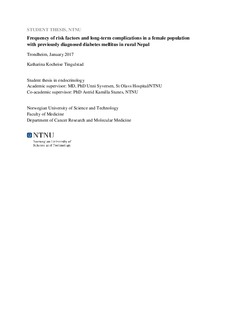| dc.description.abstract | Background: Diabetes mellitus (DM) is a noncommunicable disease causing 1.5 million deaths annually in 2012. Its global prevalence is growing dramatically, projecting to 10.4% of the adult population in 2040. Almost 75% of those with DM reside in developing countries, including Nepal. In the current study, we attempted to verify the DM diagnosis and to investigate for risk factors and DM-related complications among a small sample of women in rural Nepal.
Methods: This is a descriptive follow-up study of rural women previously identified with DM according to HbA1c measured by the Nycocard method. Data concerning demographics, lifestyle and symptoms were retrieved. Anthropometric measurements, collection of blood and urine samples, and examinations for DM-related complications were carried out. HbA1c was analyzed by a High Performance Liquid Chromatography (HPLC)-technique, cholesterol by a colorimetric assay and urine albumin by Nycocard affinity chromatography. DM and anthropometric measurements were categorized according to guidelines from ADA, WHO and NICE1.
Results: Of 100 invited women, 72 participated in the study. The overall prevalence of DM, prediabetes (PDM) and non-diabetes (nonDM) was 16.9%, 63.4% and 19.7%, respectively. Median HbA1c was 6.0% (IQR 0.6). Higher age in the PDM and DM groups was observed. Median body mass index was 25.1 kg/m2 (IQR 7.8), 66.6% being overweight or obese. BMI was similar in those with DM, PDM and nonDM. In the whole study population, 36.2% had hypertension (HT), and 15.5% had high total cholesterol levels. The latter was more frequent in those with DM, HT and older age. Prevalence of complications was as follows: 6.25% nonproliferative retinopathy, 18.6% cataract and 2.9% microalbuminuria. Symptoms and findings giving suspicion of neuropathy occurred in 76.1%. However, this percentage is unreliable due to the foot status of the women with thick and hard skin under the soles. Retinopathy, cataract and microalbuminuria were more frequent in the combined PDM/DM groups compared to nondiabetics, although not significant. Nonproliferative retinopathy and microalbuminuria were seen only in PDM/DM, while the other complications were seen in all groups. Only 45.8% had heard of DM.
Conclusion: We were able to confirm the presence of DM only in 12 of the women, while the majority had PDM. Altogether, 80.3% had PDM or DM. The occurrence of overweight/obesity and HT was high in the study population, and hypercholesterolemia was also frequent, consistent with metabolic syndrome. The prevalence of retinopathy and microalbuminuria was low, while cataract was more common. However, the low number of women with DM and several sources of errors prevented us from drawing firm conclusions on the prevalence of complications. Finally, we observed that the awareness of DM was poor. Our data show the need for implementation of preventive public health actions to reduce modifiable risk factors and increase awareness in rural Nepal. | nb_NO |
